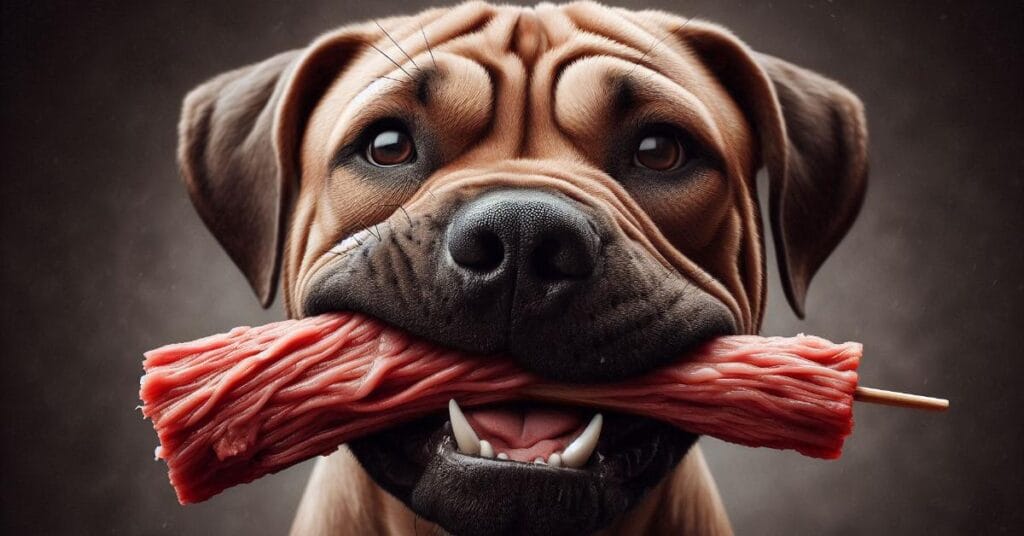Bully sticks are a favorite dog treat, but are they safe? The short answer is yes, Bully sticks are generally safe if used correctly, but there are concerns. They can help clean teeth and satisfy chewing urges but also pose choking and contamination risks. Before giving your dog a bully stick, let us read about their safety, benefits, and best practices. It’s always best to be informed when it comes to our pets!
What Are Bully Sticks?
Bully sticks (also called pizzle sticks) are a natural dog chew made from dried bull or steer phallus. While it sounds a bit strange, this single ingredient makes them a high-protein, low-fat treat for dogs.
How Are They Made?
The manufacturing process of bully sticks involves several steps to ensure they’re safe for dogs:
Sponsored Ads
- Sourcing and cleaning the raw material.
- Draining and stretching to achieve a consistent shape.
- Drying through slow roasting, baking, or smoking.
- Cutting and shaping to suitable sizes for different dogs.
Benefits of Bully Sticks
Bully sticks offer several advantages for dogs:
- Dental Health: Chewing helps clean teeth and gums by reducing plaque and tartar.
- Mental Stimulation: They satisfy a dog’s chewing instincts, keeping them entertained and potentially preventing destructive chewing.
- Nutritional Value: High in protein and amino acids, they support muscle development and overall health.
- Digestibility: Bully sticks are fully digestible, minimizing the risk of stomach problems.
Safety Concerns and Risks
While bully sticks are generally considered safe, there are some potential risks to be aware of:
Sponsored Ads
- Choking Hazard: The primary safety concern is the risk of choking, especially if a dog swallows large pieces.
- Bacterial Contamination: There’s a small risk of bacterial contamination, particularly with bully sticks produced outside the United States.
- Caloric Content: Bully sticks are high in calories, which can contribute to weight gain if not given in moderation.
- Dental Risks: While generally good for dental health, very hard bully sticks could potentially cause tooth fractures in some dogs.
Best Practices for Safe Use
To ensure your dog enjoys bully sticks safely:
- Supervision: Always watch your dog while they’re chewing on a bully stick.
- Appropriate Sizing: Choose a bully stick that’s at least 1.5 times longer than your dog’s muzzle to prevent swallowing large pieces.
- Moderation: Limit bully sticks to one per day, ensuring treats don’t exceed 10% of your dog’s daily caloric intake.
- Quality Selection: Opt for high-quality, single-ingredient bully sticks from reputable manufacturers.
- Storage: After use, allow the bully stick to air dry and store it in a cool, dry place.
- Replacement: Remove the bully stick when it becomes small enough to fit entirely in your dog’s mouth.
Comparison to Other Dog Chews
When compared to other popular dog chews, bully sticks often come out favorably:
Sponsored Ads
- Rawhide: While cheaper, rawhide poses higher risks of choking and intestinal blockage.
- Antlers: These are very durable but can potentially cause dental damage.
- Dental Chews: While good for teeth, they may not provide the same level of satisfaction as bully sticks.
- Yak Chews: These are nutritious but can also pose a choking hazard when they get small.
Bully sticks can be a safe and healthy treat for many dogs when used correctly. They’re good for teeth, mental stimulation, and nutrition. Just remember to supervise your dog, choose the right size, and give them in moderation.
FAQs
Can I give my dog a bully stick every day?
While bully sticks are generally safe, daily consumption isn’t recommended. Limit treats to 10% of your dog’s daily caloric intake. For most dogs, 2-3 bully sticks per week is more appropriate to prevent excess calorie consumption and potential digestive issues.
Sponsored Ads
What is a good alternative to bully sticks?
Several safe alternatives include:
- Dental chews specifically designed for dogs
- Kong toys filled with treats
- Natural beef tendons
- Himalayan yak chews
- Split antlers (for strong chewers)
- Carrots (for a low-calorie option)
Do bully sticks crack teeth?
While bully sticks are relatively soft compared to other chews, there’s always a small risk of dental damage, especially with very hard or dried-out sticks. Choose appropriately sized sticks and supervise chewing. Soak very hard sticks in water briefly to soften them if needed.
Why are bully sticks so expensive?
Bully sticks are expensive due to their production process – they’re made from high-quality beef, require significant processing and cleaning, and must meet strict food safety standards. The demand for natural dog treats has also increased their price.
Do bully sticks cause blockage?
Blockage can occur if dogs swallow large pieces. This risk increases when the stick becomes small enough to swallow whole. Always supervise chewing and remove the stick when it becomes small enough to swallow.
Is it OK if my dog swallowed a bully stick?
If your dog swallows a small piece, it will likely digest without issues. However, large pieces can cause choking or intestinal blockage. Monitor your dog for signs of distress like vomiting, lethargy, or constipation. Contact your vet if you notice these symptoms.
Do dogs gain weight from bully sticks?
Yes, dogs can gain weight from bully sticks as they’re high in calories. One 6-inch bully stick contains about 88 calories. Monitor your dog’s weight and adjust their regular food portions on days they receive bully sticks.
When to take a bully stick away?
Remove the bully stick when:
- It becomes small enough to swallow (usually 2-3 inches)
- Your dog has been chewing for more than 1-2 hours
- The stick becomes sharp or splintered
- Your dog becomes possessive or aggressive
How long does 1 bully stick last?
Duration varies greatly depending on your dog’s size and chewing style. For aggressive chewers, a stick might last 30 minutes, while gentle chewers might enjoy the same stick for several hours. Larger, thicker sticks typically last longer.

